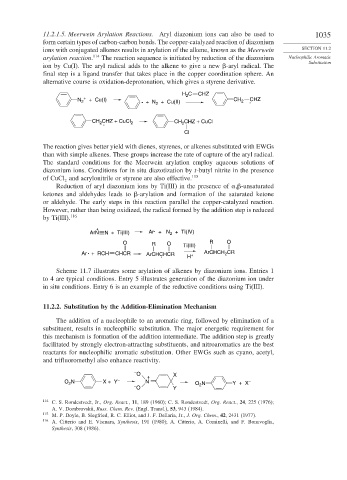Page 1059 - Advanced Organic Chemistry Part B - Reactions & Synthesis
P. 1059
11.2.1.5. Meerwein Arylation Reactions. Aryl diazonium ions can also be used to 1035
form certain types of carbon-carbon bonds. The copper-catalyzed reaction of diazonium
ions with conjugated alkenes results in arylation of the alkene, known as the Meerwein SECTION 11.2
arylation reaction. 114 The reaction sequence is initiated by reduction of the diazonium Nucleophilic Aromatic
Substitution
ion by Cu(I). The aryl radical adds to the alkene to give a new -aryl radical. The
final step is a ligand transfer that takes place in the copper coordination sphere. An
alternative course is oxidation-deprotonation, which gives a styrene derivative.
C CHZ
H 2
+
N + Cu(I) . + N 2 + Cu(II) CH 2 CHZ
.
2
CH CHZ + CuCl 2 CH CHZ + CuCl
2
2
.
Cl
The reaction gives better yield with dienes, styrenes, or alkenes substituted with EWGs
than with simple alkenes. These groups increase the rate of capture of the aryl radical.
The standard conditions for the Meerwein arylation employ aqueous solutions of
diazonium ions. Conditions for in situ diazotization by t-butyl nitrite in the presence
of CuCl and acrylonitrile or styrene are also effective. 115
2
Reduction of aryl diazonium ions by Ti(III) in the presence of , -unsaturated
ketones and aldehydes leads to -arylation and formation of the saturated ketone
or aldehyde. The early steps in this reaction parallel the copper-catalyzed reaction.
However, rather than being oxidized, the radical formed by the addition step is reduced
by Ti(III). 116
+ .
ArN N + Ti(III) Ar + N + Ti(IV)
2
O R O Ti(III) R O
.
Ar + RCH CHCR ArCHCHCR H + ArCHCH CR
2
.
Scheme 11.7 illustrates some arylation of alkenes by diazonium ions. Entries 1
to 4 are typical conditions. Entry 5 illustrates generation of the diazonium ion under
in situ conditions. Entry 6 is an example of the reductive conditions using Ti(III).
11.2.2. Substitution by the Addition-Elimination Mechanism
The addition of a nucleophile to an aromatic ring, followed by elimination of a
substituent, results in nucleophilic substitution. The major energetic requirement for
this mechanism is formation of the addition intermediate. The addition step is greatly
facilitated by strongly electron-attracting substituents, and nitroaromatics are the best
reactants for nucleophilic aromatic substitution. Other EWGs such as cyano, acetyl,
and trifluoromethyl also enhance reactivity.
– O X
–
O N X + Y N + N Y + X
–
2
– O Y O 2
114 C. S. Rondestvedt, Jr., Org. React., 11, 189 (1960); C. S. Rondestvedt, Org. React., 24, 225 (1976);
A. V. Dombrovskii, Russ. Chem. Rev. (Engl. Transl.), 53, 943 (1984).
115 M. P. Doyle, B. Siegfried, R. C. Elliot, and J. F. Dellaria, Jr., J. Org. Chem., 42, 2431 (1977).
116
A. Citterio and E. Vismara, Synthesis, 191 (1980); A. Citterio, A. Cominelli, and F. Bonavoglia,
Synthesis, 308 (1986).

